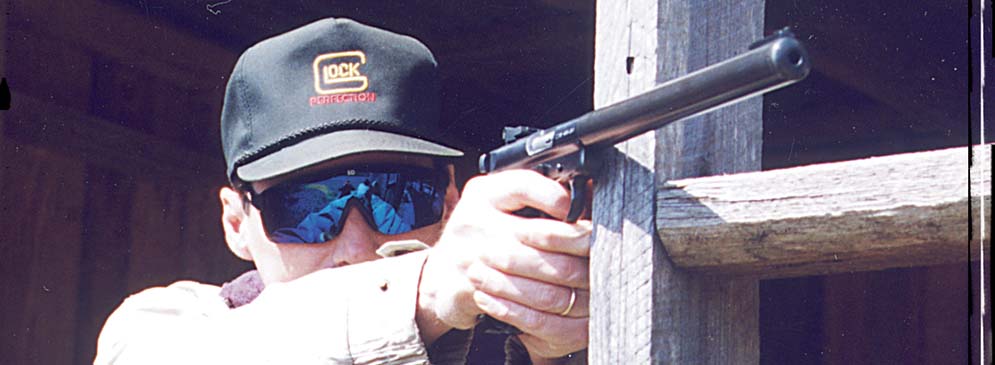By Steve Baughman
The .22 rimfire is the world’s most popular cartridge. It is economical to shoot and is generally easily to suppress due to its reduced muzzle blast. Most connoisseurs of suppressor technology eventually get around to owning a quiet 22LR pistol sooner or later. Fortunately for the buyer, there are a lot of integrally suppressed pistols on the Class III market. With the reporting of Al Paulson and others, some of the past articles in Small Arms Review have helped provide base-line comparison of sound reductions between the various manufacturers. I was curious as to what level of practical accuracy one could expect with one of these suppressed pistols, and wanted to know if it would be possible to have a quiet pistol compete with some of the rifles on the market as far as accuracy is concerned. Although I have heard that a rifle is said to be approximately 15-times more accurate than a pistol due to the way it is held and sighted, the smaller handgun package has some advantages. Reduced size and weight are the most noted conveniences. I decided to do some testing to see how one of the popular, integrally suppressed pistol units performed with a variety of ammunition. Having a few extra boxes of ammo laying around, I headed out to the range to generate some data. As usual, one thing led to another, and it turned into a fairly extensive ammo evaluation as well.
For those not familiar with suppressor technology, an integrally suppressed pistol is quite different from a muzzle can. A muzzle can is a sound-muffling device, which is usually detachable from the host weapon, and generally produces higher velocities than those produced by the ported barrel of an integral suppressor. My experience has shown that a muzzle can does not reduce muzzle velocity. The barrel porting in integral units serves to slow down most high velocity ammunition to subsonic velocities. Subsonic velocities are required to avoid the ballistic crack produced when the bullet surpasses the speed of sound. Which is better? It depends upon what the shooter wants and needs. I’ve used both over the years, and have found that both types have their own unique advantages. I prefer to keep a detachable muzzle-can dedicated to my 10/22 rifle for discreet target practice and shooting without the need for hearing protection. The unit may be easily removed from the rifle and used on other weapons if required. The integral unit, on the other hand, allows some extra latitude in ammunition selection, as just about any high velocity fodder can be used to enjoy quiet shooting activities. Most .22LR ammunition is subsonic out of a pistol barrel, in any event. The muzzle can on a rifle usually works best with subsonic ammunition, which in some cases, costs a little more than other types. With the integral unit, your standard Wal-Mart variety high velocity ammo will be bled down below the subsonic range, hence producing a quiet report while maintaining reliable functioning in a semi-auto. Whenever possible, a velocity of 1,000 fps is optimal.
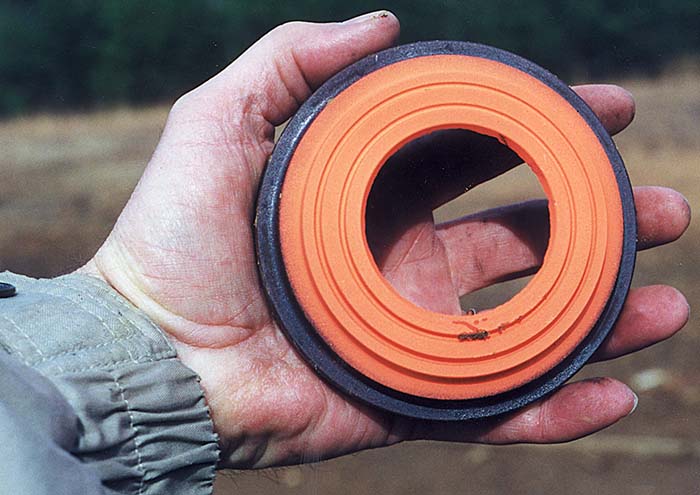
For the target shooter or plinker, the use of either suppressor design can help in allowing one to safely and economically fire thousands of rounds a year. It allows one to practice often, without traveling to distant ranges or hunting grounds. Whether used for target shooting, pest elimination, hunting (where allowed by law), or general skill improvement, the suppressor and an accurate .22 pistol is a versatile tool. The low discharge sound and negligible recoil makes shooting a flinch-free endeavor. All sports require frequent practice, and the suppressed firearm can be used to teach the elements of marksmanship, which carry over to almost all firearm shooting. The rigors of special licensing, fingerprinting, background checks, and a one-time $200 tax payment is enough trouble to keep many folks from obtaining a suppressor, but it is worth it for those who persevere. The use of a suppressor for hunting is not permitted in most states; however, they are usually legal for varmint and/or pest elimination. With less and less area available for shooting these days, a quieter gun allows one to shoot in areas that would otherwise be unavailable. I shoot in my back yard year round; sometimes firing up the Massey-Fergeson tractor in the winter months to generate a little background noise so the neighbors don’t hear the mild report of the weapon. The summertime brings out the leaves on the trees and lots of grass and undergrowth to absorb the noise even better.
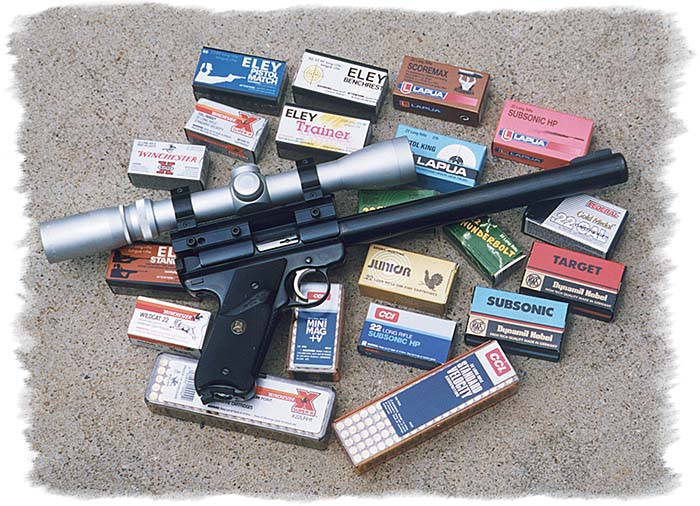
One of my favorite pastimes at the range is shooting clay birds placed along the backstop at 100-yards. I routinely set out 40 or 50 spread across the backstop. The clays are 4 inches in diameter, and make great targets. A solid hit usually provides the shooter with immediate visual feedback. After ones’ rifle accuracy improves to the point where hitting the clays is easy, it’s time to challenge your skill at the same distance with a pistol. I started migrating to the use of a 22 pistol for busting clays about a year ago. I had purchased one of Sound Technology’s integrally suppressed Ruger MkII’s, and quickly discovered that even with iron sights, the bull-barreled pistol was capable of hitting the 4-inch disks with some reasonable success on occasions depending upon ammo selection. The selection of ammo seemed to be a major factor in the hit ratio, so it was obvious that a little testing would pay off in determining which brands produced the best groups. For high volume shooters who buy ammo by the brick or case, the payback dividends of up-front tests are well worth the initial effort.
The Sound Technology’s MkII Pistol
Over two million of the Ruger autoloader pistols have been produced since 1949. Its rugged design has been extremely successful, since it is ideal for any shooting activity suited to full-sized .22 rimfire pistol use. It is also a perfect platform for modification into a suppressed firearm, and continues to be the industry standard. For the Ruger pistol, Mark White of Sound Technology usually recommends that the individual send him the host weapon in the 51/2-inch bull barrel configuration. There is an advantage in sending him a previously tested weapon. It allows the owner to ensure proper functioning and accuracy prior to being modified. Mark will then permanently install a 1 x 8, or 1 x 10 inch blued or stainless steel integral suppressor unit or a Millennium muzzle can depending upon the users needs. According to Mark, the longer integral tube provides up to 46-dB sound reduction, with an average sound level of 115 dB with high velocity ammunition. One can expect as little as 112 dB with subsonic ammunition. Mark’s muzzle can is not quite as effective, but burns cleaner and promotes more positive functioning with an unported 5.5-inch barrel. At 50 yards, the action noise can scarcely be heard.
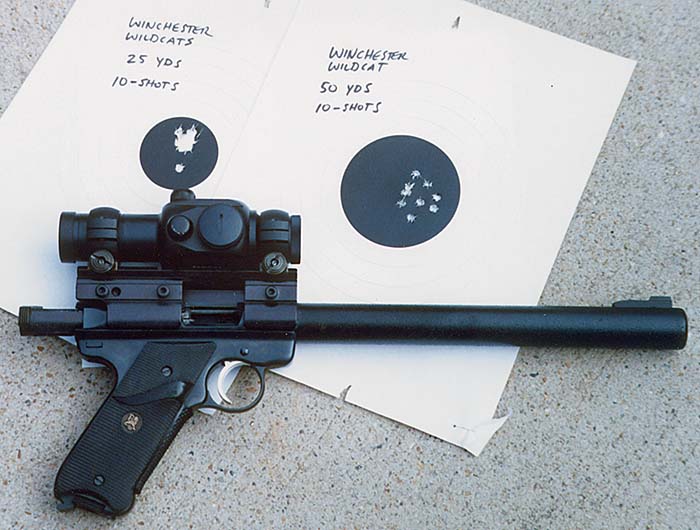
Like many integral units on the market, the suppressor unit itself resembles a factory bull barrel, and most curious observers can’t tell the difference. The original barrel is cut to about 4.4 inches in length, and is ported around 2.8 inches from the breech. The ports and drilled, reamed, and a 45 degree bevel is machined where the ports intersect the bore. The porting is done in such a way that the expansion chambers all drain towards the muzzle, so there are no areas to catch crud from the firing process. The suppressor is designed such that the unit may be cleaned and drained by immersion in solvent. Mark TIG welds the muzzle cap, then carefully grinds and polishes the surface to make it look like a factory finished unit. Mark tells me that many of the units he does end up being more accurate after he suppresses the weapon. This, he explains, is due to the fact that the reduced muzzle blast has less impact on the base of the bullet as it travels down the barrel. The Sound Technology integral suppressor is a utilitarian design, and the dominant sound heard from 30 yards away is the noise of the action cycling.
Sights/Optics:

When using iron sights, 1 or 2 clays hit out of 10 at 100-yards was the norm. Sometimes, if luck was on my side, I could hit 3 or 4. Deciding that a good quality scope would be needed to extract maximum accuracy for the tests, I installed B-Square’s MkII Dovetail mount as the base platform. The mount positions the centerline of the scope about 2-1/8 inches above the pistol’s bore. It also allows the shooter to see through the unit and to use iron sights if required, which I found a handy feature to have. I then installed a Pentax 2.5-7 pistol scope for accuracy testing. The Pentax would provide the higher power magnification needed for long range shooting, and would be set to 7 power for 50-yard testing. The addition of the scope turned the pistol into a true 100-yard competitor. With the selection of the right ammunition, one can typically hit 8 out of 10 clays at the same distance. Optical clarity and resolution was excellent out to the ranges that I was shooting the pistol. Optimum eye relief was about 12 inches.
The Pentax scope does not have a bullet drop compensator (BDC), or target knobs for the longer ranges. Typically this feature would not be a requirement for the average pistol shooter who shoots out to 50-yards. However, when using an integrally suppressed pistol, muzzle velocities can be bled down to between 750 and 850fps, so there is a fairly large bullet drop out past this range. With an unported, 5-inch pistol barrel, expect velocities to range between 870 and 1120 fps. When zeroed at 50-yards, a 10 to 12 inch drop at 100 was the norm. Although a bullet drop compensator would be a great option, the Pentax does incorporate a zero-setting adjustment. Once the windage and elevation adjustments are set, all you have to do is know the bullet drop for the particular ammo you’re using, and perform the necessary “come-ups” to compensate. One other trick is to use the top of the bottom post in a duplex crosshair as a long-range sight. I found the pistol accurate out to 50-yards, and elected to maintain the 50-yard zero for simplicity. At this setting, 25-yard impacts were about 1/2 to 3/4 inches high. At 100 yards, the transition in the bottom post is about right.

Ammo Considerations/Test Data:
My search for accurate and quiet ammunition started with the economically priced Russian Jr. Brass and CCI Standard. It soon escalated up the price range to the Federal Ultra Match and Eley Bench Rest Gold. There are those who pay for this kind of performance, so some of these more expensive rounds are included in my evaluation. I performed baseline testing with 26 different loads. All tests were done with the scope set at 7 power, and were fired from a solid bench rest with sandbags. Muzzle velocities were measured with the ProChrono-Plus chronograph. Groups were measured center-to-center with digital calipers. I averaged five, 5-shot groups and came up with the following charts depicting the baseline accuracy performance of the firearm. Good quality rimfire ammo has a wax or wax/moly coating on the bullet that aids accuracy. It sometimes takes 10 or more shots to lay a good coating of it down in the barrel. I tried to shoot 5 practice rounds of each brand prior to the measured groups to allow some stabilization and settling down. I believe that if 50 or 100 rounds were fired initially with a particular brand, the subsequent groups would have been even tighter. As one would expect, the more expensive match grade ammo usually performed the best, but there were a few surprises in the less expensive varieties. The extreme spread (lowest velocity subtracted from the highest) must be consistent for maximum accuracy at longer distances as it will affect bullet drop and trajectory. This is a function that relies heavily on ammunition quality, and is probably one of the most important factors for repeatable accuracy. There were really no losers in the ammo tests. All of the brands performed acceptably. These test results are recorded in table 1.
Outside air temperature was about 65F during my initial tests. All of the ammo tested remained subsonic, with the exception of one round of CCI’s Mini-Mag +V. This particular round produced a muzzle velocity of 1083 fps, and the familiar sound of the ballistic crack was heard. The +V averaged 1049 fps, and were the loudest of all brands tested. At 65F, the speed of sound is around 1123 fps. My shooting observations over the years have noted that as long as muzzle velocities are less than 97% of the speed of sound (Vs), the ballistic crack will not be heard. The one round at 1083 fps was very close to this 97% level, about 96.4-96.5% to be exact. Assuming my temperature and MV readings were correct, this is what should be expected. Another 10-degree F rise in temperature and all the +V would most certainly be subsonic. To put some perspective on velocity, 1083 fps equates to about 330.1 meters/second, 738.41 miles/hour, or 0.21 miles/second. For estimates of the speed of sound at various temperatures, I use the following approximations:
Overall, the pistol averaged 1.24-inch groups with all 26 brands of ammo at 50 yards. Best groups were obtained with RWS Target, Eley Bench Rest Gold, Winchester T22 Target, Federal Ultra Match, and Geco 22LR Rifle. The RWS Target and Winchester T22 were a surprise in that they are reasonably priced and yet produced excellent groups. Virtually all of the ammo produced vertical strings, hence validating the importance of extreme spread between fastest and slowest rounds. I then took the top five group producers, and fired 10-rounds each at 100-yards. The 100-yard groups overall averaged 3.84 inches, with Eley Bench Rest Gold producing the best group measuring just under 3 inches. Being produced by a suppressed pistol with a 4.4-inch barrel, I considered this excellent performance. I then mounted the excellent Baush & Lomb Elite 4000 36X scope on the pistol to retest at 100-yards. The Elite 4000 is a high performance optic, and usually accompanies me on prairie dog hunts out west. It is obviously designed for rifle target shooting, but I wanted to see what kind of groups I could produce with the pistol. I had a hard time shooting offhand with the Pentax, and usually resorted to iron sights when using the gun in the field. When not shooting from the bench, the B&L was virtually impossible to hold steady. The B-Square mount definitely is a plus in these cases since iron sights can be used for offhand shooting conditions. Taking the top ten ammunition performers from the previous test, I produced the 100-yard groups indicated in table 2.
Eventually, the optics chosen for daily tasks was a 1X Tasco Pro-Point red dot sight. This unit provides very fast target acquisition and also allows the gun to produce good accuracy out to 50 yards. It’s a little easier to carry in a holster than with a full-length pistol scope, and is much easier to hold steady while shooting offhand. Beyond 50 yards, practical accuracy is still better than iron sights, but is not quite up there with the higher-powered scopes.
Ammo Performance Observations
Typically, a 20% reduction in muzzle velocity over advertised rifle velocities was noted while testing the pistol. As expected, the pistol generally produced the best accuracy with the more expensive target grade ammunition. Over the long run, target grade ammo would probably provide the best performance for those who demand the best. I personally preferred the clean, moderately priced CCI and Winchester ammunition for general shooting activities due to the price/performance ratio. These two brands do not have the heavy wax coating on the cartridge typically used by some manufacturers. RWS Subsonic HP has always been one of my favorites due to its accuracy and quiet performance, but their wax coating is a little messy and probably necessitates additional maintenance. The same goes for RWS Target, although it came out on top for the 50-yard tests. RWS is also importing the new Geco 22LR Rifle and Pistol, which seems to have less wax coating than the Subsonic HP and Target loads. CCI and Winchester ammo is very clean on the outside and also burns cleanly, which equates to less maintenance and more shooting without downtime. My sources at CCI tell me that the +V round is going to be discontinued due to lack of sales. Their subsonic HP is still an export-only item that is unfortunately not readily available here in the states. CCI Green Tag and Standard are good solid performers as well. In the hollow point design, the Winchester Power Point was an excellent performer with a large cavity for rapid expansion. This round should be ideal for quiet pest elimination needs around the farm. T22 was moderately priced and very accurate. These two Winchester loads, along with CCI Standard, produced the best groups at 100 yards.
Maintenance of Sealed Suppressor Units:
I use Aerokroil or Du-Lite’s Kwikseal Firearms Lubricant for almost all maintenance on the integral unit. Being somewhat lazy (just ask my wife), I generally don’t clean my guns unless they are not working reliably or become excessively dirty. My normal procedure consists of blasting the chamber and internals with oil, and allowing the residue to drain down to the muzzle. Firing a few shots blows out and disperses the oils, and keeps things working well for a long time. Once a year, I plug the end of the barrel, place muzzle down, and fill the entire suppressor unit full of Aerokroil. I let the gun sit for 2 weeks or so and occasionally shake it to dislodge some of the internal gunk. After soaking, I remove the plug, drain the unit, and blow it out with compressed air. The drained cleaning fluids are usually not overly dirty, indicating that the internals are remaining fairly clean. The next task is test firing several magazines to disperse the oils.
When firing the gun after a thorough cleaning, the heat energy generated will also cook off whatever oils are left internally and produce a fair amount of smoke for the first box of ammo. It also helps make the gun quieter for a period of time until all the oils are evaporated out of the unit. Accuracy will usually be degraded until the bullets “lay down” enough coating in the bore. This can sometimes take several boxes of ammo. Obviously there are those who will disagree with my philosophy on cleaning. Many would recommend a thorough cleaning after every shooting session. This is the maintenance path I have chosen, and it seems to work well for me. Mark told me that he has taken his firearms apart which have been cleaned by immersion insolvent every 1000 rounds, and the insides were very clean. He is confident that the pistols he suppresses will remain functional indefinitely, as long as they are soaked and blown out as scheduled. His extra effort in cleaning up the porting holes in the barrel probably attribute to this.
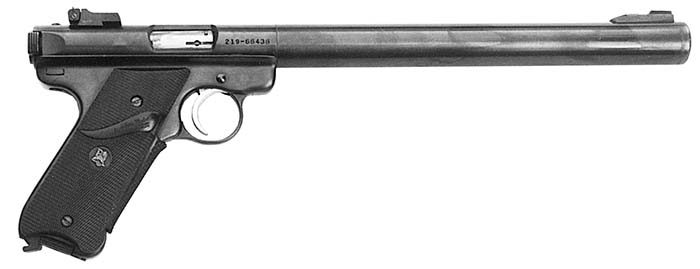
When using AeroKroil, care should be taken when used indoors. Some family members may not agree with some of us who think that solvents don’t smell so bad, and AeroKroil is definitely not aromatically pleasant. The smell does not bother me, but most people would want to use it outdoors or in well-ventilated areas. Someone in my workplace recently used some in an office area. Two people in the office panicked and called the Safety Department thinking they were under some kind of chemical attack. This situation escalated up the chain of command and ultimately resulted in OSHA getting involved and doing an investigation! The work space area was actually closed for several months while all this was going on. All that unnecessary commotion was the result of a few sprays of AeroKroil.
Carry Options:
Once the scope was mounted on the pistol it became quite a bit bulkier, and a holster/carry system was then needed. The folks at Uncle Mike’s can provide a good holster option for this unit. Their size 13 Sidekick bandoleer-hunting holster fits the gun perfectly. This model is designed to fit the scoped 14-inch barrel Thompson Center Contender. It can be used to carry the weapon across the chest or across the back. I used the holster while hiking in the north Georgia mountains for a 2-day trip, and it worked out fine. It is definitely not a quick-draw rig, but I was able to carry the gun on my back with reasonable comfort. It also protects the gun reasonably well when not carrying in a hard case.
Conclusions/Observations:
A suppressor design must be carefully thought out depending upon the user requirements. The modifications to the firearm produce a lot of changes in the muzzle blast energy as it travels around and through the barrel ports, baffles, and other components. Since shot placement is a critical requirement for the serious target shooter, the modifications to the firearm must be done in a way which does not affect accuracy. On this particular pistol, reliability proved to be greatest with the hotter rounds. The cleanliness of the gun is probably a big factor here, as rimfire ammunition is quite dirty, and easily fouls up the chamber area just ahead of the bolt. Integral systems are notorious for fouling actions. All the high velocity ammo cycled the action with 100% reliability. Some of the subsonic brands did not cycle the action with the same success, but they did produce less noise as a trade-off. It has been discussed among gun writers over the years that the temporary bond between the bolt and receiver can make the first round to go 2-3 inches high at 50-yards. The high first round syndrome was not a problem with this gun, although it may be with others. I sprayed some lubricant on the bolt face between some of the tests, and noted no such phenomenon. Overall, I was pleased (and somewhat surprised) with the accuracy results. The gun was more accurate than I initially thought it was. Although not as accurate and repeatable as a target-grade 22 rifle, the Sound Technology MkII definitely outperformed many 22 rifles I’ve owned over the years.
During one of my test sessions at the range, I met a gentleman who was quite proud of his rifle skills, and was not shy about bragging about it. After listening to him talk for a while, I challenged him to a little friendly competition, pitting his rifle against my pistol. He scoffed when I displayed the MkII, but was soon amazed when he heard how quiet the Winchester T22s were. He thought it was an air pistol, and I spent the next 15 minutes explaining the legality of suppressed firearms since he had no experience or knowledge about them. We then proceeded with the shootoff. I allowed him the first shot at each clay placed on the backstop 100-yards away. Each of his misses was followed by the quiet report of the pistol, and (usually) a broken clay. After shooting about 50 birds, I suppose the competition was essentially a draw, with the pistol seeing a slight advantage in number of hits. The gentleman was truly amazed (and somewhat disgusted) that the pistol was as about as accurate as his 22 rifle at the same distance. He was however, very impressed with the quietness of the pistol, and went away with the knowledge that suppressors are a legal and fun category of the shooting sports. The fact that it can make things happen at a distance quietly just adds icing on the cake.
Sources:
Sound Technology
Mark White
PO Box 391
Pelham, AL 35124
205-664-5860
Pentax Corporation
35 Inverness Drive East
PO Box 6509
Englewood, CO 80155-6509
303-799-8000
Bushnell Sports Optics Worldwide
9200 Cody Street
Overland Park, KS 66214
1-800-423-3537
B-Square
PO Box 11281
Fort Worth, TX 76110-0281
1-800-433-2909
Michaels of Oregon Co.
Uncle Mike’s
PO Box 13010
Portland, OR 97213
503-255-6890
Kano Products
AeroKroil
1027-R Thompson Lane
Nashville, Tennessee 37211-2627
615-833-4101
Du-Lite’s / Kwikseal
The Du-Lite Corporation
171 River Road
Middletown, CT 06457
203-347-2505
Tasco
7600 NW 26th Street
Miami, FL 33122-1494
305-591-3670
| This article first appeared in Small Arms Review V3N3 (December 1999) |



